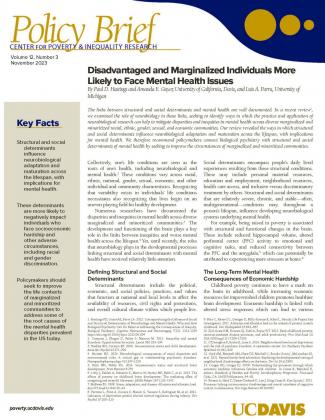Disadvantaged and Marginalized Individuals More Likely to Face Mental Health Issues
By Paul D. Hastings and Amanda E. Guyer, University of California, Davis, and Luis A. Parra, University of Michigan
The links between structural and social determinants and mental health are well documented. In a recent review[1], we examined the role of neurobiology in those links, seeking to identify ways in which the practice and application of neurobiological research can help to mitigate disparities and inequities in mental health across diverse marginalized and minoritized racial, ethnic, gender, sexual, and economic communities.
Our review revealed the ways in which structural and social determinants influence neurobiological adaptation and maturation across the lifespan, with implications for mental health. We therefore recommend policymakers connect biological psychiatry with structural and social determinants of mental health by seeking to improve the circumstances of marginalized and minoritized communities.
Key Facts
- Structural and social determinants influence neurobiological adaptation and maturation across the lifespan, with implications for mental health.
- These determinants are more likely to negatively impact individuals who face socioeconomic hardship and other adverse circumstances, including racial and gender discrimination.
- Policymakers should seek to improve the life contexts of marginalized and minoritized communities to address some of the root causes of the mental health disparities prevalent in the US today.
Background
Collectively, one’s life conditions are seen as the roots of one’s health, including neurobiological and mental health.[2] These conditions vary across racial, ethnic, national, gender, sexual, economic, and other individual and community characteristics. Recognizing that variability exists in individuals’ life conditions necessitates also recognizing that lives begin on an uneven playing field for healthy development.
Numerous researchers have documented the disparities and inequities in mental health across diverse marginalized and minoritized communities.[3] The development and functioning of the brain plays a key role in the links between inequities and worse mental health across the lifespan.[4] Yet, until recently, the roles that neurobiology plays in the developmental processes linking structural and social determinants with mental health have received relatively little attention.
Defining Structural and Social Determinants
Structural determinants include the political, economic, and social policies, practices, and values that function at national and local levels to affect the availability of resources, civil rights and protections, and overall cultural climate within which people live. Social determinants encompass people’s daily lived experiences resulting from these structural conditions. These may include personal material resources, education and employment, neighborhood resources, health care access, and inclusive versus discriminatory treatment by others. Structural and social determinants that are relatively severe, chronic, and stable—often, multigenerational—conditions may, throughout a person’s lifespan, influence developing neurobiological systems underlying mental health.
For example, being raised in poverty is associated with structural and functional changes in the brain. These include reduced hippocampal volume, altered prefrontal cortex (PFC) activity to emotional and cognitive tasks, and reduced connectivity between the PFC and the amygdala,[5] which can potentially be attributed to experiencing more stressors at home.[6]

The Long-Term Mental Health Consequences of Economic Hardship
Childhood poverty continues to leave a mark on the brain in adulthood, while increasing economic resources for impoverished children promotes healthier brain development. Economic hardship is linked with altered stress responses which can lead to various physical and mental health problems.[7] Hypercortisolism is more prevalent in infants and younger children living in poverty,[8] whereas hypocortisolism emerges after more time spent in poverty,[9] potentially reflecting the cumulative toll of poverty-related stress. Childhood poverty also predicts elevated tonic and reactive cardiovascular activity, especially blood pressure, in adolescence and adulthood.[10]
Location matters, too. Disparities between neighborhoods prospectively predict the prevalence of psychiatric disorders,[11] and neighborhood characteristics have been associated with the neurobiology underlying mental health. Independent of family economic resources, living in neighborhoods with greater poverty, deterioration, and crime during childhood or adolescence is associated with patterns of neural reactivity indicative of accelerated brain maturation.[12] It is also associated with either dampened or sensitized neural reactivity in multiple brain regions that control behavior and emotion.
Links between childhood adversities (e.g., family poverty) and later psychopathology are mediated through accelerated maturation of emotion-processing, and deficits in reward-processing. Socioeconomic status (SES) has consequences for family processes,[13] and links between family SES and brain functioning and development are themselves mediated by effects of economic adversity on family functioning.[14] The clinical implications of these effects on connectivity may present as emotion dysregulation, attention inflexibility, and inefficiencies and biases in processing information, among other symptoms.
Address the Root Causes of Mental Health Disparities
Standard interventions for mental health problems typically treat symptoms rather than root causes. To address those root causes and develop systems-level interventions to disrupt fundamental structural and social causes of disease at both individual and community levels, it is necessary to identify and understand neurobiological mechanisms by which adversity, classism, sexism, heterosexism, transphobia, and racism contribute to mental health disparities. Bolstering antidiscrimination policies may help dismantle barriers to access to housing, employment, education, and fair treatment among economic, ethnic, racial, sexual, and gender minorities. More inclusive laws, policies, and practices support healthier brain development, which in turn promotes better mental and physical health.
Some such laws and policies exist, but often are not upheld. Governments need to be held accountable in exercising these protective measures. This extends to social safety-net programs as well as to violence prevention and gun-control legislation, natural-disaster emergency-response programs, and pollution-control efforts, all of which disproportionately adversely affect marginalized and minoritized communities. Meanwhile, in many jurisdictions, new legislation is imposing new structural inequities by, for example, denying gender-affirming health care to transgender minors or restricting school curricula from addressing the topic of structural and social determinants.
Given the extensive evidence for the profound effects of structural and social determinants of mental health, policymakers should seek to improve the life contexts of marginalized and minoritized individuals. Doing so would potentially address some of the root causes of the mental health disparities prevalent in the US today.
Amanda E. Guyer is a professor of human development and family studies and associate director of the Center for Mind and Brain at UC Davis.
Paul D. Hastings is a professor of psychology and faculty researcher at the Center for Mind and Brain at UC Davis.
Luis A. Parra earned his PhD in human development at UC Davis and is now an assistant professor in the School of Nursing at the University of Michigan.
References
1. Hastings PD, Guyer AE, Parra LA. 2022. Conceptualizing the Influence of Social and Structural Determinants of Neurobiology and Mental Health: Why and How Biological Psychiatry Can Do Better at Addressing the Consequences of Inequity. Biological Psychiatry: Cognitive Neuroscience and Neuroimaging 7(12): 1215-1224. https://doi.org/10.1016/j.bpsc.2022.06.004
2. Campion J, Bhugra D, Bailey S, Marmot M. 2013. Inequality and mental disorders: Opportunities for action. Lancet 382:183–184
3. Bradley RH, Corwyn RF. 2002. Socioeconomic status and child development. Annu Rev Psychol 53:371–399
4. Harnett NG. 2020. Neurobiological consequences of racial disparities and environmental risks: A critical gap in understanding psychiatric disorders. Neuropsychopharmacology 45:1247–1250
5. Brito NH, Noble KG. 2014. Socioeconomic status and structural brain development. Front Neurosci 8:276
6. Luby J, Belden A, Botteron K, Marrus N, Harms MP, Babb C, et al. 2013. The effects of poverty on childhood brain development: The mediating effect of caregiving and stressful life events. JAMA Pediatr 167:1135–1142
7. McEwen BS. 1998. Stress, adaptation, and disease. Allostasis and allostatic load. Ann N Y Acad Sci 840:33–44
8. Perrone L, Frost A, Kuzava S, Nissim G, Vaccaro S, Rodriguez M, et al. 2021. Indicators of deprivation predict diurnal cortisol regulation during infancy. Dev Psychol 57:200–210
9. Blair C, Raver CC, Granger D, Mills-Koonce R, Hibel L, Family Life Project Key Investigators. 2011. Allostasis and allostatic load in the context of poverty in early childhood. Dev Psychopathol 23:845–857
10. Ziol-Guest KM, Duncan GJ, Kalil A, Boyce WT. 2012. Early childhood poverty, immune-mediated disease processes, and adult productivity. Proc Natl Acad Sci USA 109(Suppl 2):17289–17293
11. O’Donoghue B, Roche E, Lane A. 2016. Neighbourhood level social deprivation and the risk of psychotic disorders: A systematic review. Soc Psychiatry Psychiatr Epidemiol 51:941–950
12. Gard AM, Maxwell AM, Shaw DS, Mitchell C, Brooks-Gunn J, McLanahan SS, et al. 2021. Beyond family-level adversities: Exploring the developmental timing of neighborhood disadvantage effects on the brain. Dev Sci 24:e12985
13. Conger RD, Conger KJ. 2008. Understanding the processes through which economic hardship influences families and children. In Crane R, Marshall E, editors. Handbook of Families and Poverty: Interdisciplinary Perspectives. Thousand Oaks, CA: SAGE Publications, 64–81
14. Brieant A, Herd T, Deater-Deckard K, Lee J, King-Casas B, Kim-Spoon J. 2021. Processes linking socioeconomic disadvantage and neural correlates of cognitive control in adolescence. Dev Cogn Neurosci 48:100935












